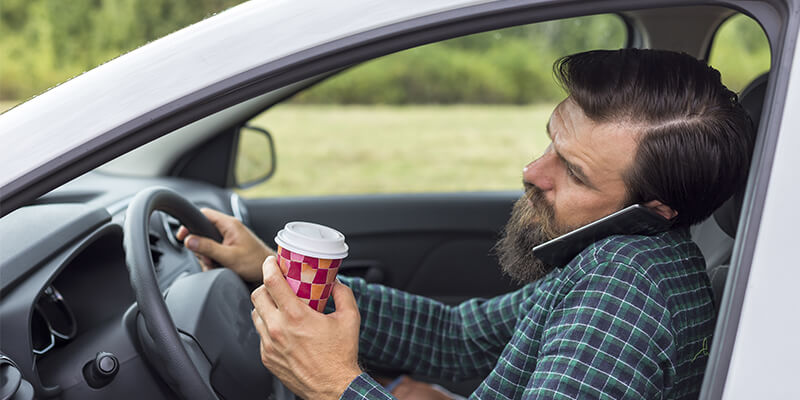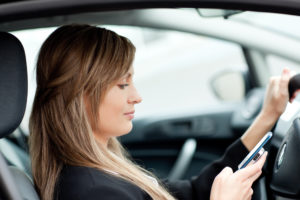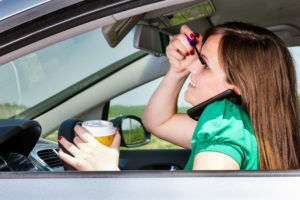Distracted Drivers – So Many Ways To Get distracted

There are certain driving rules set in stone like driving on the right side of the road and stopping at a light when it turns red. These are a necessity in order to maintain order and traffic fluidity. However, traffic laws can only do so much; in the end, the responsibility falls on the driver’s shoulders to follow these laws and pay attention to all that’s happening on the road.

Almost all driving calamities are caused by our inability to concentrate. Anything that garners your attention and takes your mind off the road greatly improves your chances of being involved in an accident. Without 100 percent of your effort focused on driving, your reaction to a dangerous obstacle will be delayed much longer than it should.
A Rampant Problem
Paying attention at all times is the golden rule of driving. According to a study by the National Highway Traffic Safety Administration in spring of 2006, some type of driver distraction occurred in every four out of five crashes and 65 percent of close calls within three seconds of the incident. In other words, it only took mere seconds of limited attention to cause a disaster.
This day and age, multitasking in the driver’s seat is becoming the norm. Automobile manufacturers seem to be filling their vehicles with all sorts of amenities as subtle as cup holders or as obvious as DVD players and LCD screens installed in the dashboard. It is practically acceptable to see drivers:
• Eating or drinking.
• Surfing through radio stations.
• Switching CDs
• Talking on a cell phone.
• Engaging in conversation with passengers.
• Tending to children who demand attention
• Reading.
All of the above activities compromise the driver’s capacity to scrutinize and respond to the rapidly changing environment of the road.
Changing your viewpoint
Safe driving is dependent upon driver attitudes; drivers who consider their vehicles extensions of their homes may have a tendency to overlook safety in favor of convenience and entertainment value. On the other hand, those who distinguish their vehicles as extremely large and powerful weapons waiting to be misused are more apt to view driving in the literal sense—an intricate task that requires total attentiveness if it is to be done correctly.
Curbing driver distractions
• Ensure that young passengers are comfortable and appropriately fastened in child seats. To prevent children from bothering the driver, give them safe materials to keep them busy (e.g., coloring books, stuffed animals, etc.). Make sure pets are secured inside their carriers as well.
• Stop the car if you or anyone else in the vehicle intends to eat or drink. It is possible for anybody to choke if they are chewing while the car is moving, creating a major disruption for the driver. By pulling over, you give you and your passengers the opportunity to take a break from the stress associated with traffic and enjoy your pick-me-up without having to rush.
• Plan out your journey before you get going. If you’re unsure of the area, pull off to the side of the road to plot the route and avoid the hassle of looking at a map while trying to watch the road.
• Finish primping yourself before leaving the house. Never attempt to shave, put on makeup, or brush your hair while operating a motor vehicle.
• Do not participate in arguments or upsetting conversations with passengers or over the phone. These situations can lead to aggressive or unpredictable driving patterns.
• Proceed with caution, and prepare yourself for bad weather or careless drivers, pedestrians, or cyclists that you may share the road with.
• Get to know your vehicle inside and out, especially internal switches and dials that control various mechanisms. This is absolutely necessary if you are driving an unfamiliar vehicle such as a new or rental car. Prior to shifting to drive, practice using these instruments so that you can perform vital tasks such as running the headlights, wipers, and defrosters without having to look.
• The only thing your hands should be touching is the steering wheel, and the only thing your eyes should be looking at is the road while the vehicle is in motion. Unless you have a hands-free kit or Bluetooth headset, you should not be talking on a cell phone while driving. Make your calls before departing from your home or office, or else postpone them until you reach your destination. In the meantime, anyone trying to reach you can leave messages on your voicemail. If it happens to be an emergency, pull off to the shoulder or into a parking lot to use the phone. More on this website
